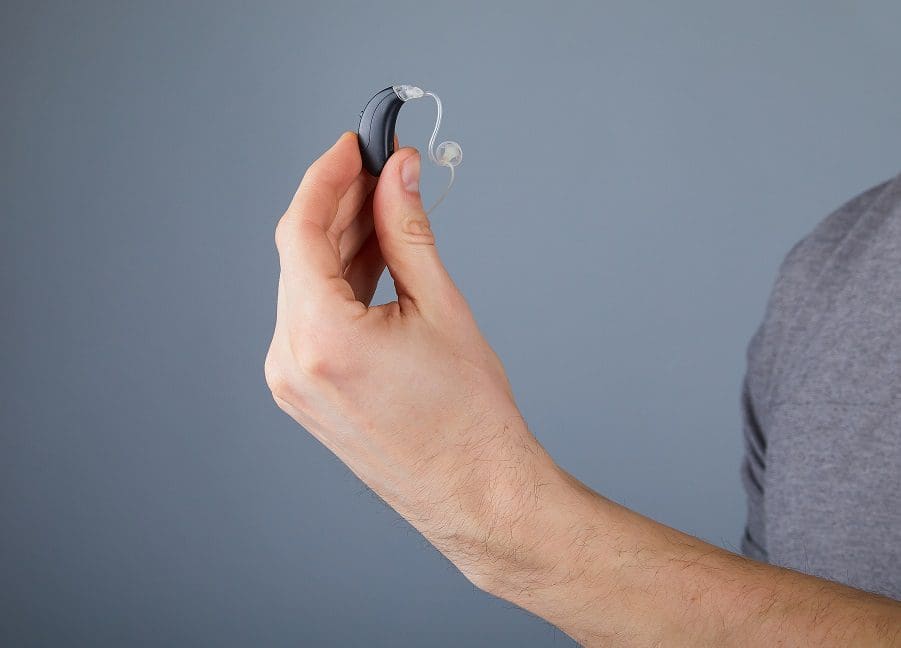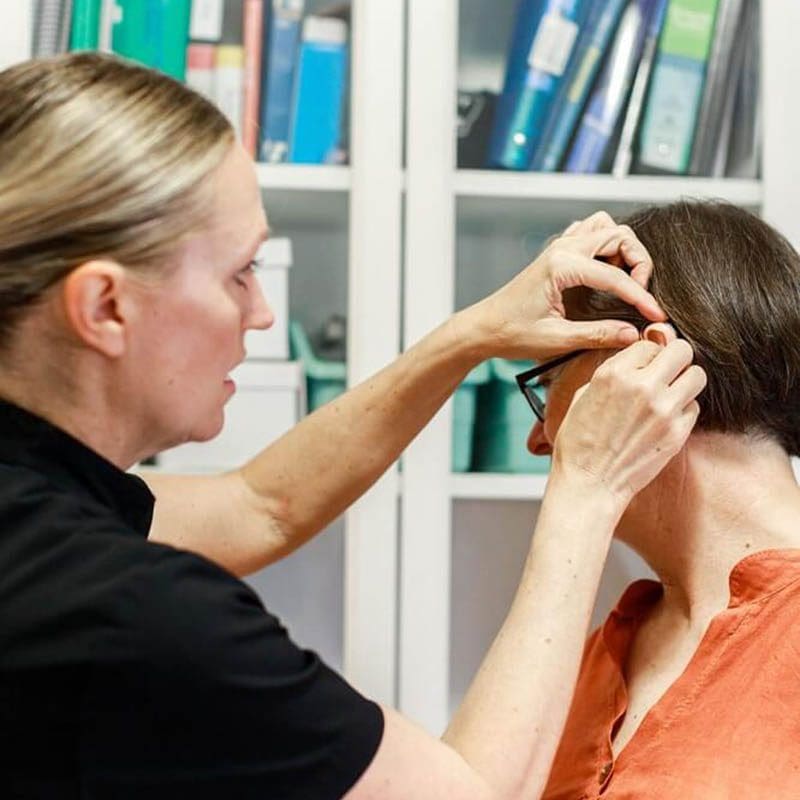Advanced Hearing Aid Technology Delivered to Your Home
If you’re like most people, you probably envision those bulky, clunky gadgets our parents or grandparents wore whenever hearing aids are mentioned. Outdated stigmas attached to hearing aids are one of the biggest reasons people avoid addressing their hearing challenges.
Just like cell phones, modern hearing aid technology is nothing like the devices used a decade ago.
Today’s hearing instruments are small, discreet and, in some cases, nearly invisible.
In fact, many of the individuals we work with tell us that their friends and/or colleagues have never even noticed they are wearing them.
The modern hearing aids available from Hear at Home are more powerful, feature long-lasting rechargeable batteries, include programmable and automated noise cancellation.
They also have the capacity to stream music, phone calls and audio from your smartphone, television, PC or other digital devices directly to your hearing aids, amplifying your hearing and your life.


What are prescription hearing aids?
Prescription hearing aids are designed to amplify sound for individuals with hearing loss and are specifically programmed to match your unique hearing requirements. Unlike over-the-counter models, these devices are customized according to your audiogram, providing a superior fit and enhanced performance. Our tailor-made hearing aids aim to improve your hearing, boost your ability to communicate and enhance your overall quality of life.
We Go Beyond
We Go Beyond Helping You Choose a Hearing Aid
There is a wide selection of advanced hearing aid technology available with a host of unique features from brand name manufacturers such as Phonak, Starkey, Unitron, Signia and Bernafon.
Thanks to innovations in micro-digital and material technology, today’s hearing aids come in a variety of different sizes and colours to meet lifestyle and personal preferences.
Besides helping you choose the right technology to meet your needs, our hearing care specialists program your new hearing aids to address your specific hearing loss needs.
To make things as easy as possible, we will also teach you, your family and your caregivers how to insert and remove your hearing aids.
We also educate you on proper cleaning and care of your hearing instruments, changing batteries and troubleshooting the most common issues.


We Want Your Hearing Aids To Always Be At Their Best For You
Since hearing aids are minicomputers placed in the moist, waxy environment of your ears, regular cleaning and TLC is essential for both longevity and performance. We want you to be comfortable with your new device, so we don’t rush through these appointments.
All of the hearing aids we fit come with a 30-day trial period (extensions are available when necessary).
Our hearing aid technicians are eager to make any necessary modifications and ensure your satisfaction.
We keep in touch and encourage annual checkups to review your hearing level and check that your aids are working appropriately.
In addition, depending on your hearing aid model and age, as well as access to a smartphone, our technicians may be able to remotely program and adjust your hearing aids for you.
Myths and Facts
Some Common Myths and Facts About Hearing Aids
Myth: Personal sound amplifiers (PSAs) and hearing aids are basically the same.
Fact: Not true. The designed objective for a PSA is to increase the overall volume for recreational activities. They are not able to adapt to the noise environment around you, cancel out background noise, provide great hearing clarity or address hearing challenges in specific frequencies like hearing aids. When not used as they are intended, PSAs can damage your hearing and are not an adequate alternative for hearing aids.
Myth: Hearing aids make everything too loud.
Fact: Thanks to advanced sound processing to improve clarity and noise-reduction technology, today’s hearing aids adapt to each sound environment as you move from place to place. Their advanced technology does more than just amplify sound; they provide the best solution to address your unique type and severity of hearing loss as well as fit into your lifestyle.
Myth: Hearing aids are bulky and make people look old.
Fact: Micro-digital technology, similar to what is used in your smartphone, has made it possible to manufacture hearing aids that are smaller, lighter weight and nearly invisible, but with ever-increasing power to improve hearing clarity. The capabilities of today’s technology to fit all lifestyles make it possible to continue living the way you’re used to without anyone ever knowing that you’re wearing a hearing aid.
Myth: Hearing aids are too expensive.
Fact: Well-fit, well-maintained devices, along with hearing care provided by a hearing care professional, seem expensive until you consider the costs of untreated hearing loss. If hearing loss is left untreated, it can lead to depression and anxiety, strained relationships, cognitive decline, dementia, balance disorders and decreased productivity. In addition, improperly programmed PSAs or OTC hearing aids can add to the damage.
Myth: Hearing aids will cure my hearing loss.
Fact: Hearing aids cannot cure hearing loss. They are called “aids” because they help retrain your brain to pick up the sounds that hearing loss has conditioned it to miss. That’s why ongoing support is a critical part of getting your hearing aids to work for and with you.
Myth: I hear just fine out of my good ear, so I only need one hearing aid.
Fact: Most likely your “good ear” is the one you learn to favour for the telephone or group conversations, making you believe that your hearing in the better ear is normal. The vast majority of hearing challenges affect both ears equally, and nearly 90% of people with a hearing loss in one ear need hearing aids for both ears.
Myth: I only struggle with some, but not all, sounds, so I don’t need hearing aids.
Fact: Hearing loss is a loss of certain sounds, not all sounds, but if you’re missing some of the sounds, you’re missing all of the conversation. Hearing care professionals program hearing aids to amplify the sounds you’re missing and enhance the clarity of the hearing that’s left.
Schedule a Comprehensive Hearing Assessment
Getting the right device to meet your unique hearing needs is a critical element in better hearing. Before choosing the device that is best suited for addressing your needs, you need a professional comprehensive hearing assessment.
If you or a loved one believes it might be time to take advantage of today’s advanced hearing aid technology, complete and submit the adjacent form and we’ll call you back to schedule an appointment.
"*" indicates required fields
Patient Stories
No matter what happens in the world, these people remain the centre of ours.
Blog
You Asked, We Answer
What are the Causes and Effects of Hidden Hearing Loss?
Maintain Hearing Health With These Daily Activities
Cerumen (Ear Wax) Buildup: Causes, Symptoms, and Removal
At Your Home, Or Ours.



